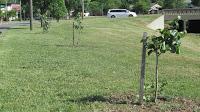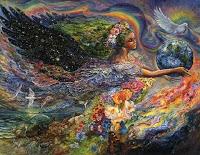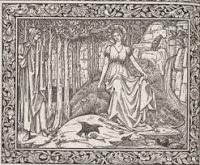 [Cross-posted to By Common Consent]
[Cross-posted to By Common Consent]This is an expanded and re-written version of a Mother's Day sermon I gave in church last week, on May 13, 2018.
I'm pretty certain that ever since I became old enough to wonder about matters theological, I hadn't been all that enthused by the Mormon idea of Mother in Heaven. The Christian message which consistently spoke (and still speaks) most strongly to me was Pauline, Augustinian, and Lutheran; I took (and still take) seriously the omniscience and omnipresence of God presented through the Biblical tradition, and saw His relationship with us as profoundly grace-centered and not at all humanist. This left little room in my thinking for the discourse about Heavenly Mother that I was most familiar with, which seemed rooted in deeply literal and humanist presumptions about God's identity, sexuality, and relationships. "In the heav’ns are parents single?/ No, the thought makes reason stare! / Truth is reason; truth eternal / Tells me I’ve a mother there"--to a great many of my fellow Mormons, for many years, the claim made in this old hymn seems both persuasive and obvious. But it wasn't for me.
I write all that in the past tense, though, because not too long ago I read an essay which made me realize that maybe, just maybe, I've actually been thinking about, and perhaps even worshiping, Mother in Heaven all along. But let me work around to that.
 Over the past two years, a large number of the trees which once lined the run-off beside the street in front of our home were affected by a blight, and were removed by the city. Last summer, they were replaced with saplings--many of which, I noticed over our long dry winter, got snapped off. Maybe the wind did it, but more likely it was stupid kids wandering along the street. And yet today all of them, even those that were left stubby and close to the ground, are growing. Rain finally came to this part of Kansas, and growth has too.
Over the past two years, a large number of the trees which once lined the run-off beside the street in front of our home were affected by a blight, and were removed by the city. Last summer, they were replaced with saplings--many of which, I noticed over our long dry winter, got snapped off. Maybe the wind did it, but more likely it was stupid kids wandering along the street. And yet today all of them, even those that were left stubby and close to the ground, are growing. Rain finally came to this part of Kansas, and growth has too. One of the most common themes in our sacrament meetings is "gratitude," and this is something I'm grateful for: the abundance of the natural world all around us, the rhythm of growth that returns, again and again, even in the face of all the harm we do to creation. It's an abundance we are invited, despite all our environmental crimes, to contribute to and benefit from, and by so doing learn from as well. That's something else to be grateful for: the satisfaction--and the often humbling learning which precedes that feeling of satisfaction--of being a part of nature's cycle of renewal and bounty. I grew up working in gardens, bailing hay, tromping through alfalfa fields, milking cows by hand, and the productive interplay of us human beings with the growing, gracious things that fill our stomachs with food and our minds with beauty is something that, even as an academic, attends much of my thinking. If you're looking for a romantic agrarian, someone who enjoys weeding the tomato plants and contemplating the meaning of the soil as I turn it over with a spade, you've got one right here.
The week before I was assigned to speak, we sang in church one of my favorite hymns: "All Creatures of our God and King." The fourth verse, in particular, caught by eye:
Dear Mother Earth, who day by day
Unfoldest blessings on our way,
Alleluia! Alleluia!
The flowers and fruits that in thee grow,
Let them His glory also show.
Alleluia! Alleluia!
Alleluia! O praise Him! Alleluia!
The lyrics of this hymn are a slightly changed version of those composed by William H. Draper, who in the early 1900s translated St. Francis of Assisi’s poem "Canticle of the Sun," which was written around 1224, and inspired by the 148th Psalm. Here's a translation of the relevant passage from the poem:
Praised be You, my Lord, through Sister Mother Earth,
who sustains us and governs us and who produces
varied fruits with colored flowers and herbs.
Draper was inspired to see in that poem a hymn something he wanted to his congregation to be able to hear and sing for a Whitsunday service--Whitsunday being an old English liturgical term for the Day of Pentecost, the day, seven weeks after Easter, that the Christian world celebrates the blessing of Holy Ghost which comes to surround and sustain Jesus's disciples and all who come into His community. There is a reason, I think, why this particular work by St. Francis spoke to Draper as he made plans for this holy day--specifically, the association between the manifold gifts of the spirit, and the diverse fecundity of the natural world, which Francis placed all together in his poem as a family: Brother Sun, Sister Moon, Brother Wind, Sister Water, Brother Fire. Note, though, that his "Nature" is not only a sibling; she is also a "Mother," by which and through which the governing, productive rule of life--the fruit and herbs we consume from the world, and the flowers by which it is decorated--is sustained.
Where did this idea come from, that the natural world, the world we work in and are sustained and enlightened by, is both feminine and maternal? If you turn to non-Christian history and mythology, there are plenty of ancient examples: Durga in Hinduism, Gaia from the Greeks. But these deities often are understood as embodying the wildness of the natural world, and are indifferent to, or often hostile towards, actual human beings. What of the image of nature as something which mothers us, feeds and teaches and overseas and loves us, and to which we owe the respect that we do to a mother?
The earliest example of a "Mother Nature" that I know of came from the pen of the French cleric Alain de Lille, who wrote, perhaps 60 years before St. Francis's "Canticle," a Latin work of theology titled (in translation) The Plaint of Nature. There is much in this work of prose and verse which audiences today might find strange or offensive--but it also gave the Christian world, for the first time we have record of, the idea of Nature as a ruling, feminine figure:
 O child of God, the mother of Creation, bond of the universe and its stable link....you, who by your reins guide the universe, unite all things in a stable and harmonious bond and wed heaven to earth in a union of peace; who, working on the pure idea of Divine Wisdom, mold the species of all created things...
O child of God, the mother of Creation, bond of the universe and its stable link....you, who by your reins guide the universe, unite all things in a stable and harmonious bond and wed heaven to earth in a union of peace; who, working on the pure idea of Divine Wisdom, mold the species of all created things...In the words of James Sheridan, translator of The Plaint, Nature comes to declare that "it was God's will that by a mutually related circle of birth and death, transitory things should be given stability by instability, endlessness by endings, eternity by temporariness, and that the series of things should ever be knit by successive renewals of birth." The idea of an immanent order, always linked, always disciplining, always rewarding.
I learned about Alain de Lille's Plaint from a long essay by Wendell Berry, the poet, novelist, critic, farmer, and agrarian, who once famously declared “I’d rather rely on Mother Nature’s wisdom than man’s cleverness.” Contained in his latest collection, The Art of Loading Brush, "The Presence of Nature in the Natural World" is a deep dive into the depictions of nature in the history of English literature, and its influence on consequent writings about conservation and farming. His study is often a tendentious one (he doesn't like industrial agriculture, or tractors, for that matter), but it is revealing nonetheless. His aim to remind his readers that observers of the natural world have consistently recognized that there is an order to it, a miraculous rhythm that follows a mysterious logic which we can learn from, but never master.
Berry is a Christian, a man who knows the Bible very well, but who sometimes has a problem with the conventionality of Christianity in America. He is drawn to those who seem to him to respect the mystery, the glory, the stern wonder of creation, rather than those who want to explain it all in some tidy ideological or theological package. Thomas Merton, a French Catholic who settled in a monastery in Kentucky, where Berry also lives, wrote a prose poem about the “Hagia Sophia” or “divine wisdom,” an ancient Christian idea found in 1 Corinthians 2:7 ( “But we speak the wisdom of God in a mystery, even the hidden wisdom, which God ordained before the world unto our glory”) which Alain de Lille associated with the "mother of Creation," and Francis of Assisi with "Sister Mother Earth": "There is," Merton wrote, "in all visible things an invisible fecundity, a dimmed light, a meek namelessness, a hidden wholeness. This mysterious Unity and Integrity is Wisdom, the Mother of all, Natura naturans."
 In the centuries between Alain de Lille of the 12th century and Berry and Merton of the 20th, many other authors strove to capture the order, surprise, and wisdom of nature--and again and again, their intuition of such took feminine and maternal forms. Geoffrey Chaucer's poem The Parlement of Foules presents Mother Nature as the "vicar of the almighty Lord" who "hot, cold, heavy, light, moist, and dry / Hath knit by even numbers of accord," bringing a wise balance to the renewing, reproducing processes of of nature. Edmund Spenser's Two Cantos of Mutabilitie, which were appended to The Faerie Queene, also gives us the "great dame Nature / With goodly Port and gracious Majesty / Being far greater and more tall of Stature / Than any of the Gods or Powers on high," who, when confronted with the challenge of Mutability, imposes a larger, deeper, unseeable order upon the changeableness of creation. John Milton’s allegorical poem Comus presents us with Nature ("the Lady") wisely resisting those that would indulge in nature’s bounty, instead insisting on "Temperance" so that "Nature’s full blessings would be well dispensed in...even proportion."
In the centuries between Alain de Lille of the 12th century and Berry and Merton of the 20th, many other authors strove to capture the order, surprise, and wisdom of nature--and again and again, their intuition of such took feminine and maternal forms. Geoffrey Chaucer's poem The Parlement of Foules presents Mother Nature as the "vicar of the almighty Lord" who "hot, cold, heavy, light, moist, and dry / Hath knit by even numbers of accord," bringing a wise balance to the renewing, reproducing processes of of nature. Edmund Spenser's Two Cantos of Mutabilitie, which were appended to The Faerie Queene, also gives us the "great dame Nature / With goodly Port and gracious Majesty / Being far greater and more tall of Stature / Than any of the Gods or Powers on high," who, when confronted with the challenge of Mutability, imposes a larger, deeper, unseeable order upon the changeableness of creation. John Milton’s allegorical poem Comus presents us with Nature ("the Lady") wisely resisting those that would indulge in nature’s bounty, instead insisting on "Temperance" so that "Nature’s full blessings would be well dispensed in...even proportion."  This only scratches the surface of this one linguistic, poetic tradition (Berry goes on to consider the realization of Nature, and its wise discipline, in the works of Pope, Wordsworth, and Ezra Pound as well), but the themes, I think, are clear. For many Christian artists and thinkers, to take seriously God's creation is to take seriously the idea that some part of God, or something suitably God-like, overseas it, blesses it, makes it meaningful and a source of bounty and wisdom to those who tend to it, and issues a reproach to those who do not. Is this Mormon doctrine, or even Christian, for that matter? Not directly. But the more that I think about it, the less I can read any of revelations of Joseph Smith dealing with the natural world, with their insistence upon bounty, respect, patience, and humble and equitable use--see Doctrine and Covenants 49:18-21, D&C 59:15-21, or D&C 104:14-18--without imaging a distinctly maternal, a loving but also wise and watchful, eye behind them. It is the same loving (but unsentimental) eye I think sometimes I can see through, when I look upon our often frustrating, but just as often rewarding, front yard flower and strawberry patch, when it is weeded and well-watered and flourishing. In it, I sometimes see something more than my work--I see labor in the soil made meaningful. Guided, one might say, to becoming a part of the abiding spiritual rhythms of the natural world.
This only scratches the surface of this one linguistic, poetic tradition (Berry goes on to consider the realization of Nature, and its wise discipline, in the works of Pope, Wordsworth, and Ezra Pound as well), but the themes, I think, are clear. For many Christian artists and thinkers, to take seriously God's creation is to take seriously the idea that some part of God, or something suitably God-like, overseas it, blesses it, makes it meaningful and a source of bounty and wisdom to those who tend to it, and issues a reproach to those who do not. Is this Mormon doctrine, or even Christian, for that matter? Not directly. But the more that I think about it, the less I can read any of revelations of Joseph Smith dealing with the natural world, with their insistence upon bounty, respect, patience, and humble and equitable use--see Doctrine and Covenants 49:18-21, D&C 59:15-21, or D&C 104:14-18--without imaging a distinctly maternal, a loving but also wise and watchful, eye behind them. It is the same loving (but unsentimental) eye I think sometimes I can see through, when I look upon our often frustrating, but just as often rewarding, front yard flower and strawberry patch, when it is weeded and well-watered and flourishing. In it, I sometimes see something more than my work--I see labor in the soil made meaningful. Guided, one might say, to becoming a part of the abiding spiritual rhythms of the natural world.I realize that if this is an argument for Mother in Heaven, it is a distinctly panentheistic one, with some feminine element of the divine being made manifest through (though not necessarily being identical to) God's creation. I'm happy with that accusation, though. I think it is necessary, if one insists upon doing theology, to be willing to consider such categories, or else one is going to be stuck with a terribly reductive literalism (case in point: the plain comment by Mormon apostle Erastus Snow in March 1878 that "I must believe that deity consists of man and woman" and that we Mormons worship a "Godhead composing two parts, male and female" causing a minor hermaphroditic freak-out in the footnotes to the BYU Studies article cited above).
In the same way that we Christian believers need to be willing to think expansively about we mean when we talk about the Holy Ghost in the connection with Pentecost--remember that in the Fifth of Smith's early Lectures on Faith the Holy Spirit, which in Biblical history begins with the idea of the ruach Elohim or the Breath of God, was identified with the mind of God the Father--we similarly need to think expansively about Heavenly Mother. Might She be that title which we could give (and maybe, through Mother Nature, always have given) to that part of God which is invested in creation, in the wise, tutelary, fecund impulse which governs nature and those of use who live off of and through its creative rewards? No scriptural account that I consider at all inspired says so, in so many words. But lately, I find I'm persuaded that it makes sense.
In the Mother's Day service where I gave the original version of this sermon, the Primary children sang two songs: "Mother Dear" and "My Heavenly Father Loves Me." Both wonderful, sweet songs. And yet, the association they make together--one song about the love one has for mothers, the other about an appreciation for creation--can be achieved much more directly, I thought, by just one song, one of the wisest Primary tunes of all:
I often go walking in meadows of clover,
And I gather armfuls of blossoms of blue.
I gather the blossoms the whole meadow over;
Dear mother, all flowers remind me of you.
O mother, I give you my love with each flower
To give forth sweet fragrance a whole lifetime through;
[And this, right here, I think, is the key verse, the one that really brings it all home:]
For if I love blossoms and meadows and walking,
I learned how to love them, dear mother, from you.
Blossoms and meadows and walking. Which mother did that teaching, do you suppose? The child's, presumably. But also...maybe, another One as well? Some patient mothering spirit or thought, some sehnsucht that calls to us, without us knowing why or how, helping us see something meaningful, something orderly, in every spring surprise, in every growing and good thing. In the Book of Mormon, Alma claimed that "the earth, and all things that are upon the face of it...denote there is a God." He didn't know the half of it, perhaps. Paying attention to, and learning to be properly grateful for the other Half, the Half that we've always known, and named Mother Nature, and yet not always fully seen, may be one of our tasks today. It is one that I long thought I'd dismissed--but yet, I think now that I've been looking for Her all along.
